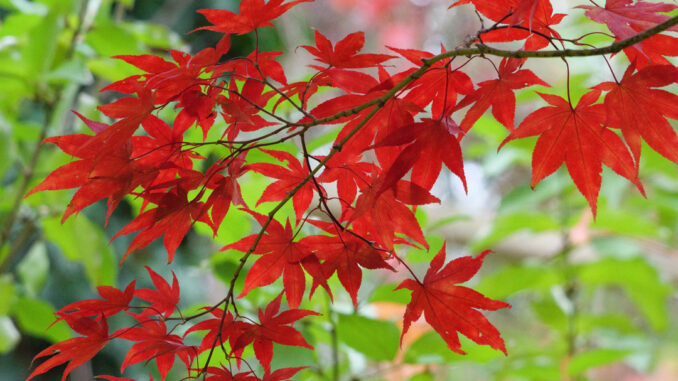
Finally, time to relax and consider the merits of leaves as a natural solution to gardening problems. And a preview of spring just when you need it!
Low cost, high reward
The colourful ruckus of summer petals is over and the cold months of leisure are upon us. You might currently be surfing, or mountain trekking, or curled up in front of a toasty fire. Whatever the location, now is the opportunity to consider all of the ways in which the garden could be better next summer – without actually grabbing a trowel and getting to work. Perhaps just the thought of garden work causes too much mental fatigue. But there might be just one important change that would conserve soil moisture, increase nutrient availability to plants and deny weed seeds a start in life – all this at no cost and without increasing labour. That would be an idea with appeal!
Every plant in the garden – perennials, vines, shrubs, trees – is dependent on the quality of the real estate beneath your feet. Poor soil conditions make plants vulnerable to stunted growth, winter damage, disease, infections and premature death. Soil problems are also labour-intensive for gardeners dealing with heavy compacted clay and poor drainage.
Whatever your soil condition, it will be improved by a protective layer of leaves and conifer needles contributing organic material and nutrients, slowing moisture evaporation and suppressing weed growth. You will quickly see the labour-saving benefits to using organic material as an attractive, sweet-smelling mulch in flower beds, around shrubs and under hedges and trees. With repeated seasonal use, leaves will contribute a compost layer, lightening heavy clay and helping sandy soil retain moisture. Weed seeds will be deprived of the sunlight that they require for germination, and established weeds will have to work harder to reach light.
Roots of woody shrubs and trees draw nutrients from the earth and incorporate them into their bark and foliage. (This is why animals chew bark in the winter – to obtain the nutrients.) Nutrients are released when leaves fall in autumn and are processed by worms and soil microbes, effectively composting in place and returning them to the soil for plant use the following growing season. This is the basic premise of forest growth, where leaves and conifer needles make a thick mulch over soil that is renewed every autumn. A generous layer of leaf mulch also provides sufficient fertilizer for a home vegetable garden.
Imagine your garden 300 years in the past, before it had a street address and when there was a forest that fed itself with leaves and conifer needles. If you remove the autumn leaves, packing them in bags for municipal collection, what remains of your forest will be deprived of sustaining nutrients. Tree leaves are a significant source of carbon, nitrogen, phosphorus and potassium, the basic plant nutrients needed for growth. Conifer needles also contain these nutrients and will not affect the balance of alkalinity and acid in soil. (Their acidic content is quickly processed and neutralized by soil microbes.)
What tree leaves to use? All tree and shrub leaves will be useful, but size matters. Small leaves such as birch, sumac, lilac, willow, ginkgo, English oak (with small leaves), silver maple (with incised leaves), locust and Japanese maples of all kinds combine with cedar, spruce and pine needles to make an effective mulch. Put down a generous layer four to six inches thick in autumn, and the weight of snow will cause it to sink by more than half in spring. Soil should never be bare if you want to keep it healthy, and a thick autumn leaf layer will leave enough for the following summer’s mulch. Large and broad leaves such as Norway maple, oak and catalpa are slower to break down if used exclusively; but these can represent up to 50 per cent of the mix when combined with smaller leaves. Crisply dried leaves of every kind can be spread across the grass and shredded with a lawn mover directly into the lawn.
Immediate signs of healthier soil next summer will be better moisture retention during heat and droughts, and fewer new weed colonies. Improvements will continue with additional organic materials laid down every autumn. This one simple procedure is cost-efficient, quickly accomplished and results in longer and healthier plant life. And you’ll be a happier gardener, too.
Spring preview
The stretch from late winter to earliest spring is a frustrating wait, with little outside relief from the frozen landscape. But bringing cut branches from flowering shrubs and trees into your warm rooms can result in a forced-flower preview of the spring that is just around the corner. Branches must have been outdoors for a period of at least eight weeks below 40F (4C) temperature before they can initiate their flower buds.
Cut branches from spring flowering shrubs such as forsythia, redbud, apricot, magnolia, apple, cherry and quince, being sure to select wood with visible premature buds present. Put the branches into water and keep in a warm room away from direct sunlight. It may take two weeks before buds begin to swell, and they can then be put into brighter light.
The vase water should be changed every second day. Commercial floral preservative can be used to prevent bacterial growth. A homemade preservative contains two tablespoons of white vinegar, two tablespoons of sugar, and ½ teaspoon of household bleach mixed into a quart of warm water. Stir to dissolve the sugar and replace the solution twice weekly.


